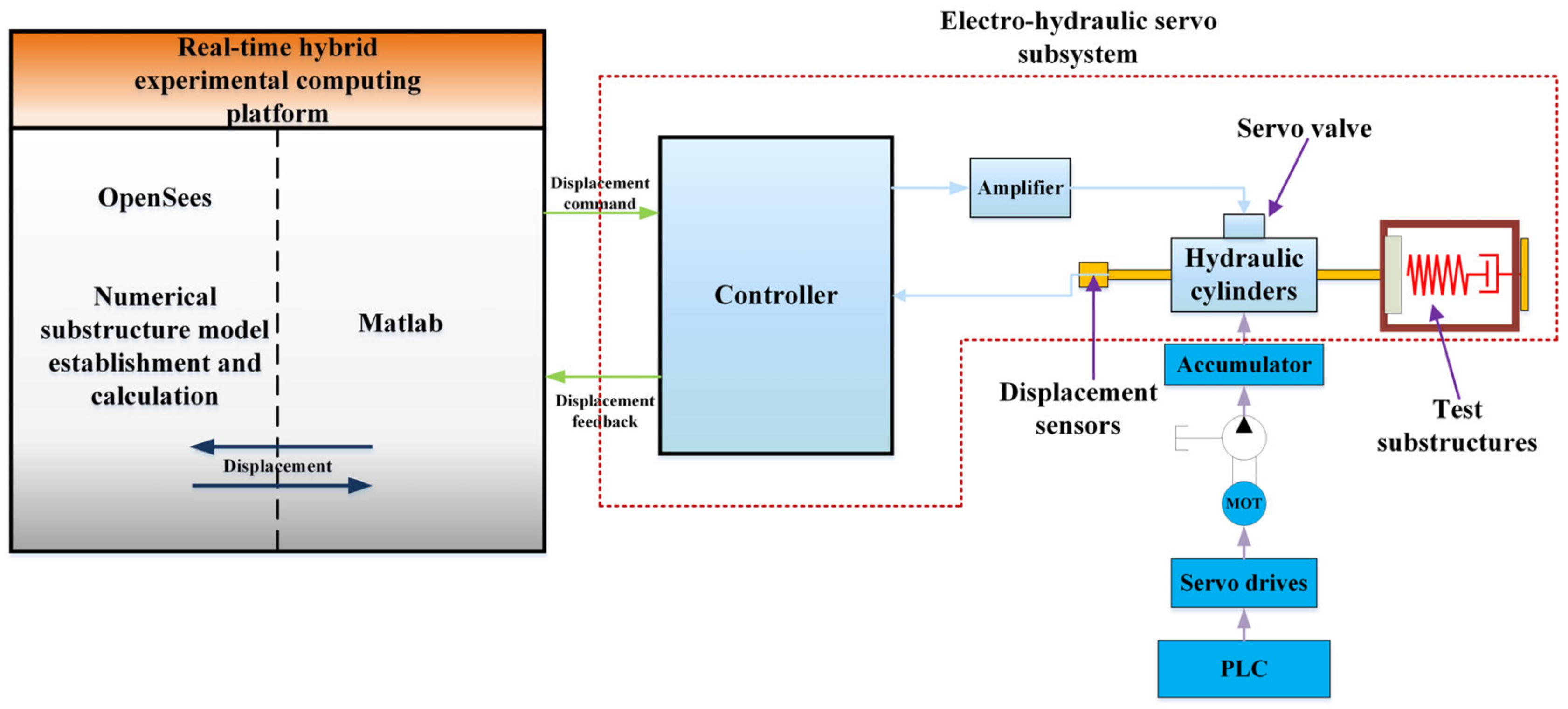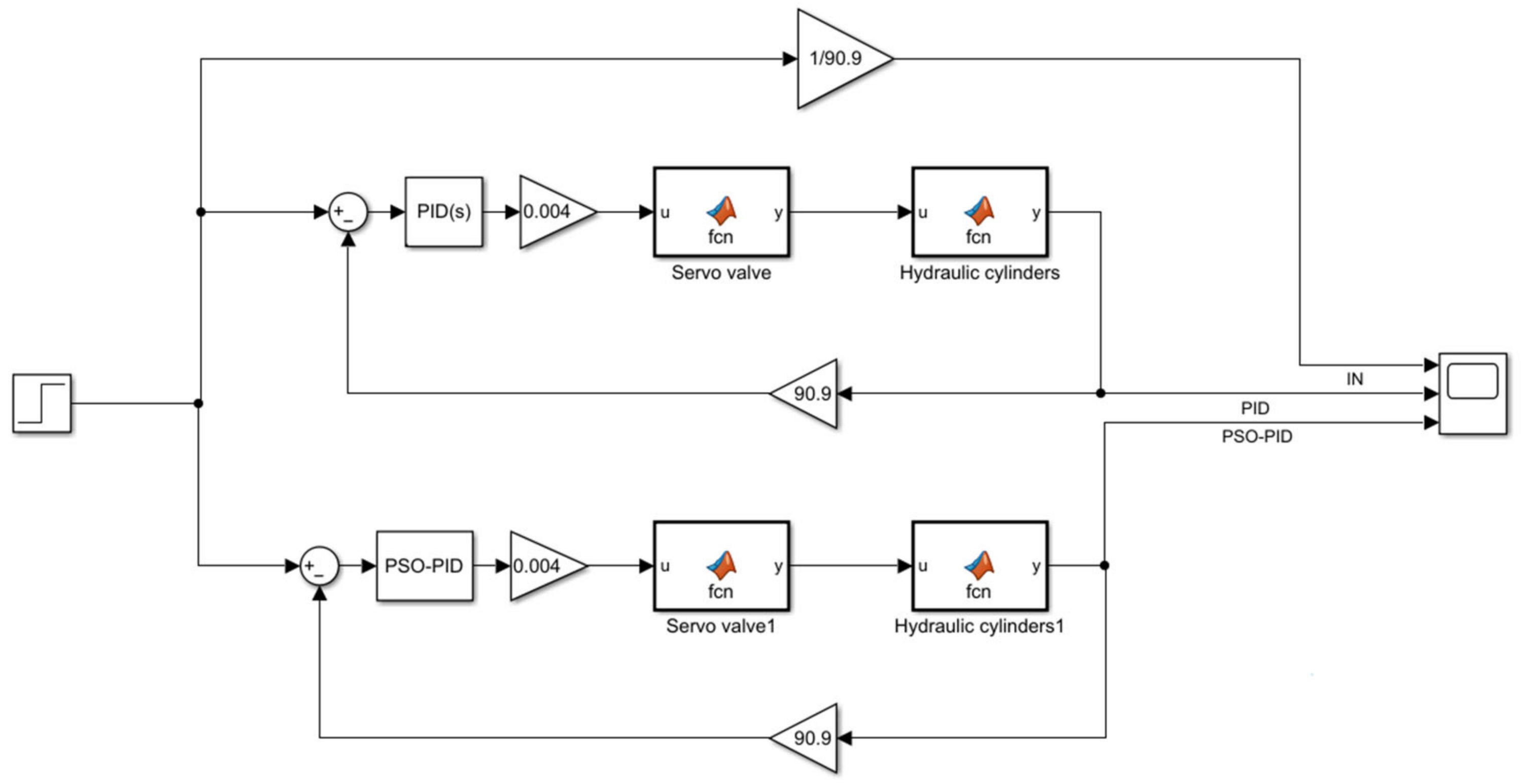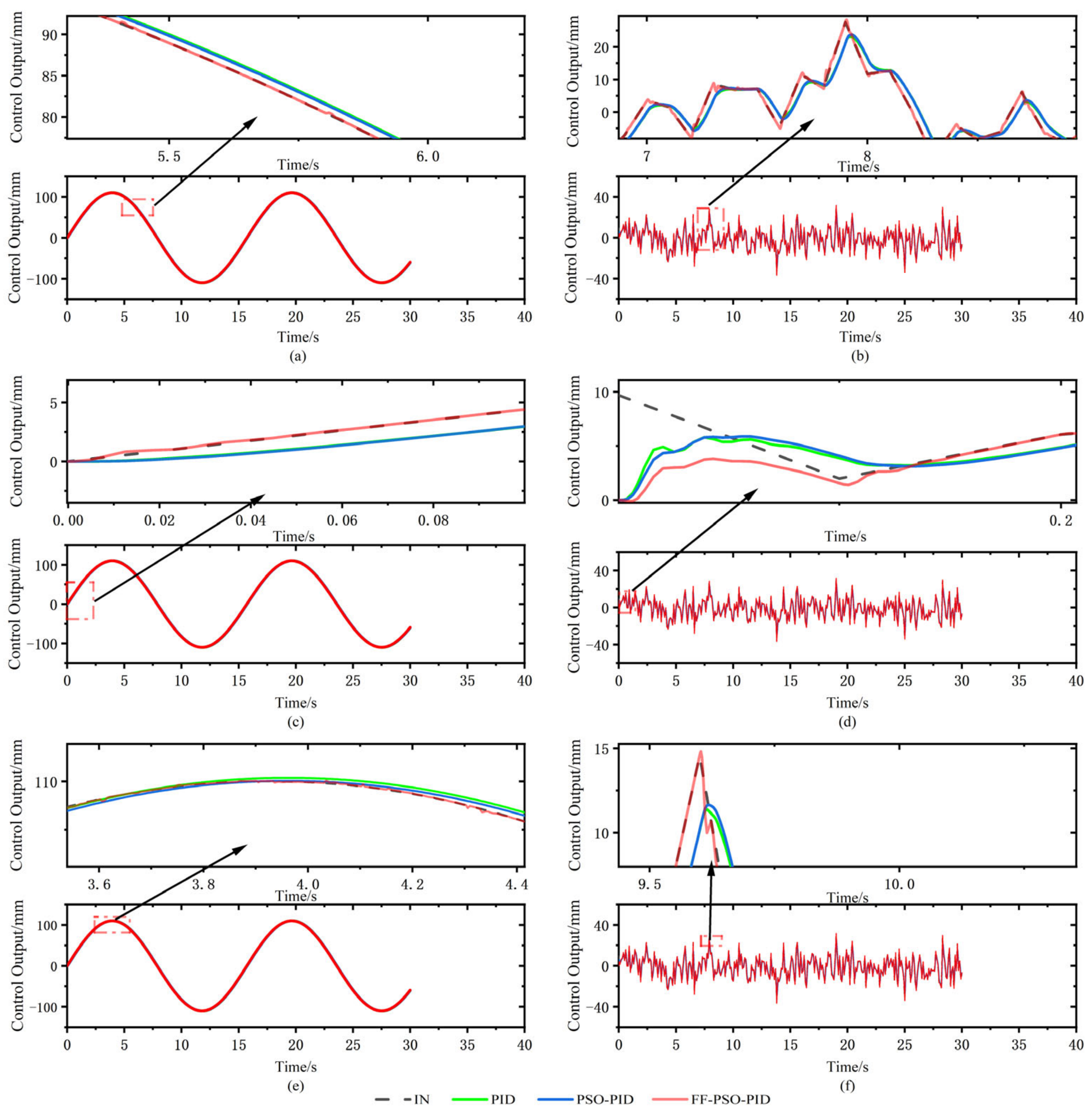Real-Time Hybrid Test Control Research Based on Improved Electro-Hydraulic Servo Displacement Algorithm
Abstract
1. Introduction
2. Real-Time Hybrid Test System
2.1. Electro-Hydraulic Servo System
2.1.1. Hydraulic Cylinder Model
2.1.2. Servo Valve Model
2.1.3. Servo Amplifier and Displacement Sensor Model
3. PID Control Algorithm
4. FF-PSO-PID Control Algorithm
4.1. PSO Algorithm Optimizes PID Parameters
4.1.1. PSO Update Rules
4.1.2. Design of the Objective Evaluation Function
4.2. Feed-Forward Compensation Control
4.3. Hybrid Algorithm for Feed-Forward Compensation and Improved PSO-Optimized PID
5. Simulation and Analysis
6. Conclusions
- (1)
- The conventional PID relies on manual experience requiring a lot of time for debugging, it cannot find the appropriate parameters accurately, and it has the disadvantages of large displacement error and long response time. Therefore, for the application background of a real-time hybrid test, the control algorithm of PSO-PID for improving electro-hydraulic servo system is proposed accordingly. In the experiments, the PSO-PID algorithm effectively reduces the displacement error, but the response speed is not improved much, and the hysteresis problem still exists.
- (2)
- In order to improve the tracking performance and response speed of the real-time hybrid test (RTH) system and solve the problems of the system in response lag and complex input signal, displacement feed-forward compensation control is introduced based on the PSO-PID algorithm. Through experimental comparison, the proposed FF-PSO-PID algorithm effectively improves the response speed of the electro-hydraulic servo system, reduces the displacement error, and solves the problem of system response hysteresis. The superior tracking accuracy is obtained under multiple input signals, verifying that the FF-PSO-PID algorithm can work effectively under complex signals. The effectiveness and superiority of the FF-PSO-PID algorithm is verified. It can effectively solve the problems of time lag, large error, and slow response of real-time hybrid tests (RTH).
Author Contributions
Funding
Institutional Review Board Statement
Informed Consent Statement
Data Availability Statement
Conflicts of Interest
References
- Shing, P.B.; Nakashima, M.; Bursi, O.S. Application of Pseudodynamic Test Method to Structural Research. Earthq. Spectra 1996, 12, 29–56. [Google Scholar] [CrossRef]
- Dermitzakis, S.N.; Mahin, S.A. Development of Substructuring Techniques for On-Line Computer Controlled Seismic Performance Testing; University of California: Berkeley, CA, USA, 1985. [Google Scholar]
- Pan, P.; Nakashima, M.; Tomofuji, H. Online Test Using Displacement–Force Mixed Control. Earthq. Eng. Struct. Dyn. 2005, 34, 869–888. [Google Scholar] [CrossRef]
- Bessa, W.M.; Dutra, M.S.; Kreuzer, E. Sliding Mode Control with Adaptive Fuzzy Dead-Zone Compensation of an Electro-Hydraulic Servo-System. J. Intell. Robot Syst. 2010, 58, 3–16. [Google Scholar] [CrossRef]
- Cerman, O.; Hušek, P. Adaptive Fuzzy Sliding Mode Control for Electro-Hydraulic Servo Mechanism. Expert Syst. Appl. 2012, 39, 10269–10277. [Google Scholar] [CrossRef]
- Luo, S.; Yang, W.; Tang, H. A Novel Feature Selection Method to Boost Variable Predictive Model–Based Class Discrimination Performance and Its Application to Intelligent Multi-Fault Diagnosis. Meas. Control 2020, 53, 104–118. [Google Scholar] [CrossRef]
- Yang, G.; Zhu, T.; Yang, F.; Cui, L.; Wang, H. Output Feedback Adaptive RISE Control for Uncertain Nonlinear Systems. Asian J. Control 2023, 25, 433–442. [Google Scholar] [CrossRef]
- Xie, X.; Xu, C.; Gu, Z. Further Studies on State Estimation of Discrete-Time Nonlinear Circuits Based on a Switching-Type Multi-Instant Fuzzy Observer. IEEE Trans. Circuits Syst. II Express Briefs 2022, 69, 3505–3509. [Google Scholar] [CrossRef]
- Zhu, R.; Fei, Q.; Jiang, D.; Marchesiello, S.; Anastasio, D. Bayesian Model Selection in Nonlinear Subspace Identification. AIAA J. 2022, 60, 92–101. [Google Scholar] [CrossRef]
- Yin, L.; Deng, W.; Yang, X.; Yao, J. Finite-Time Output Feedback Control for Electro-Hydraulic Servo Systems with Parameter Adaptation. Machines 2021, 9, 214. [Google Scholar] [CrossRef]
- Yao, Z.; Yao, J.; Sun, W. Adaptive RISE Control of Hydraulic Systems with Multilayer Neural-Networks. IEEE Trans. Ind. Electron. 2019, 66, 8638–8647. [Google Scholar] [CrossRef]
- Fu, X.; Liu, B.; Zhang, Y.; Lian, L. Fault Diagnosis of Hydraulic System in Large Forging Hydraulic Press. Measurement 2014, 49, 390–396. [Google Scholar] [CrossRef]
- Du, H.; Shi, J.; Chen, J.; Zhang, Z.; Feng, X. High-Gain Observer-Based Integral Sliding Mode Tracking Control for Heavy Vehicle Electro-Hydraulic Servo Steering Systems. Mechatronics 2021, 74, 102484. [Google Scholar] [CrossRef]
- Guo, K.; Wei, J.; Fang, J.; Feng, R.; Wang, X. Position Tracking Control of Electro-Hydraulic Single-Rod Actuator Based on an Extended Disturbance Observer. Mechatronics 2015, 27, 47–56. [Google Scholar] [CrossRef]
- Guo, Q.; Zhang, Y.; Celler, B.G.; Su, S.W. Backstepping Control of Electro-Hydraulic System Based on Extended-State-Observer With Plant Dynamics Largely Unknown. IEEE Trans. Ind. Electron. 2016, 63, 6909–6920. [Google Scholar] [CrossRef]
- Sa, Y.; Zhu, Z.; Tang, Y.; Li, X.; Shen, G. Adaptive Dynamic Surface Control Using Nonlinear Disturbance Observers for Position Tracking of Electro-Hydraulic Servo Systems. Proc. Inst. Mech. Eng. Part I J. Syst. Control Eng. 2022, 236, 634–653. [Google Scholar] [CrossRef]
- Shi, Z.; Gu, F.; Lennox, B.; Ball, A.D. The Development of an Adaptive Threshold for Model-Based Fault Detection of a Nonlinear Electro-Hydraulic System. Control Eng. Pract. 2005, 13, 1357–1367. [Google Scholar] [CrossRef]
- Deng, W.; Yao, J.; Ma, D. Robust Adaptive Precision Motion Control of Hydraulic Actuators with Valve Dead-Zone Compensation. ISA Trans. 2017, 70, 269–278. [Google Scholar] [CrossRef]
- Sinthipsomboon, K.; Hunsacharoonroj, I.; Khedari, J.; Pongaen, W.; Pratumsuwan, P. A Hybrid of Fuzzy and Fuzzy Self-Tuning PID Controller for Servo Electro-Hydraulic System. In Proceedings of the 2011 6th IEEE Conference on Industrial Electronics and Applications, Beijing, China, 21–23 June 2011; pp. 220–225. [Google Scholar]
- Xingxu, W.; Guang, H.; Rui, G. PID Sliding Mode Control for Electro-Hydraulic Servo System. J. Phys. Conf. Ser. 2019, 1168, 022085. [Google Scholar] [CrossRef]
- Bishop, C.M. Neural Networks and Their Applications. Rev. Sci. Instrum. 1994, 65, 1803–1832. [Google Scholar] [CrossRef]
- Yang, G.; Zhu, T.; Wang, H.; Yang, F. Disturbance-Compensation-Based Multilayer Neuroadaptive Control of MIMO Uncertain Nonlinear Systems. IEEE Trans. Circuits Syst. II Express Briefs 2022, 69, 1487–1491. [Google Scholar] [CrossRef]
- Hong, Z.; Kaifang, D.; Tingqi, L. A Online-Trained Neural Network Controller for Electro-Hydraulic Servo System. In Proceedings of the 4th World Congress on Intelligent Control and Automation (Cat. No.02EX527), Shanghai, China, 10–14 June 2002; Volume 4, pp. 2983–2986. [Google Scholar]
- Nakashima, M.; Kato, H.; Takaoka, E. Development of Real-Time Pseudo Dynamic Testing. Earthq. Eng. Struct. Dyn. 1992, 21, 79–92. [Google Scholar] [CrossRef]
- Horiuchi, T.; Inoue, M.; Konno, T.; Namita, Y. Real-Time Hybrid Experimental System with Actuator Delay Compensation and Its Application to a Piping System with Energy Absorber. Earthq. Eng. Struct. Dyn. 1999, 28, 1121–1141. [Google Scholar] [CrossRef]
- Horiuchi, T.; Konno, T. A New Method for Compensating Actuator Delay in Real–Time Hybrid Experiments. Philos. Trans. R. Soc. London. Ser. A Math. Phys. Eng. Sci. 2001, 359, 1893–1909. [Google Scholar] [CrossRef]
- Tang, R.; Zhang, Q. Dynamic Sliding Mode Control Scheme for Electro-Hydraulic Position Servo System. Procedia Eng. 2011, 24, 28–32. [Google Scholar] [CrossRef]
- Guan, C.; Pan, S. Adaptive Sliding Mode Control of Electro-Hydraulic System with Nonlinear Unknown Parameters. Control Eng. Pract. 2008, 16, 1275–1284. [Google Scholar] [CrossRef]
- Feng, L.; Yan, H. Nonlinear Adaptive Robust Control of the Electro-Hydraulic Servo System. Appl. Sci. 2020, 10, 4494. [Google Scholar] [CrossRef]
- Çetin, Ş.; Akkaya, A.V. Simulation and Hybrid Fuzzy-PID Control for Positioning of a Hydraulic System. Nonlinear Dyn. 2010, 61, 465–476. [Google Scholar] [CrossRef]
- Yao, J.; Jiang, G.; Gao, S.; Yan, H.; Di, D. Particle Swarm Optimization-Based Neural Network Control for an Electro-Hydraulic Servo System. J. Vib. Control 2014, 20, 1369–1377. [Google Scholar] [CrossRef]
- Feng, H.; Song, Q.; Ma, S.; Ma, W.; Yin, C.; Cao, D.; Yu, H. A New Adaptive Sliding Mode Controller Based on the RBF Neural Network for an Electro-Hydraulic Servo System. ISA Trans. 2022, 129, 472–484. [Google Scholar] [CrossRef]
- Zheng, X.; Su, X. Sliding Mode Control of Electro-Hydraulic Servo System Based on Optimization of Quantum Particle Swarm Algorithm. Machines 2021, 9, 283. [Google Scholar] [CrossRef]
- Feng, H.; Ma, W.; Yin, C.; Cao, D. Trajectory Control of Electro-Hydraulic Position Servo System Using Improved PSO-PID Controller. Autom. Constr. 2021, 127, 103722. [Google Scholar] [CrossRef]
- Fan, Y.; Shao, J.; Sun, G. Optimized PID Controller Based on Beetle Antennae Search Algorithm for Electro-Hydraulic Position Servo Control System. Sensors 2019, 19, 2727. [Google Scholar] [CrossRef] [PubMed]
- Ma, Y.; Gu, L.-C.; Xu, Y.-G.; Shi, L.-C.; Wang, H.-T. Research on Control Strategy of Asymmetric Electro-Hydraulic Servo System Based on Improved PSO Algorithm. Adv. Mech. Eng. 2022, 14, 16878132221096226. [Google Scholar] [CrossRef]
- Guo, Y.-Q.; Zha, X.-M.; Shen, Y.-Y.; Wang, Y.-N.; Chen, G. Research on PID Position Control of a Hydraulic Servo System Based on Kalman Genetic Optimization. Actuators 2022, 11, 162. [Google Scholar] [CrossRef]













| Parameters | Value |
|---|---|
| Piston rod inner diameter | |
| Hydraulic cylinder internal volume | |
| Work itinerary | |
| Servo valve rated current | |
| Parameters | Value |
|---|---|
| Parameters | PID | PSO-PID |
|---|---|---|
| Parameters | PID | PSO-PID |
|---|---|---|
| ) | ||
| 0.46 s | 0.36 s | |
| 0.2% | 0.036% |
Disclaimer/Publisher’s Note: The statements, opinions and data contained in all publications are solely those of the individual author(s) and contributor(s) and not of MDPI and/or the editor(s). MDPI and/or the editor(s) disclaim responsibility for any injury to people or property resulting from any ideas, methods, instructions or products referred to in the content. |
© 2023 by the authors. Licensee MDPI, Basel, Switzerland. This article is an open access article distributed under the terms and conditions of the Creative Commons Attribution (CC BY) license (https://creativecommons.org/licenses/by/4.0/).
Share and Cite
Shen, Y.; Guo, Y.-Q.; Zha, X.; Wang, Y. Real-Time Hybrid Test Control Research Based on Improved Electro-Hydraulic Servo Displacement Algorithm. Sensors 2023, 23, 4765. https://doi.org/10.3390/s23104765
Shen Y, Guo Y-Q, Zha X, Wang Y. Real-Time Hybrid Test Control Research Based on Improved Electro-Hydraulic Servo Displacement Algorithm. Sensors. 2023; 23(10):4765. https://doi.org/10.3390/s23104765
Chicago/Turabian StyleShen, Yaoyu, Ying-Qing Guo, Xiumei Zha, and Yina Wang. 2023. "Real-Time Hybrid Test Control Research Based on Improved Electro-Hydraulic Servo Displacement Algorithm" Sensors 23, no. 10: 4765. https://doi.org/10.3390/s23104765
APA StyleShen, Y., Guo, Y.-Q., Zha, X., & Wang, Y. (2023). Real-Time Hybrid Test Control Research Based on Improved Electro-Hydraulic Servo Displacement Algorithm. Sensors, 23(10), 4765. https://doi.org/10.3390/s23104765








